人教版(PEP)小学英语六年级上册期末复习知识点精华打印版
- 格式:doc
- 大小:56.50 KB
- 文档页数:7
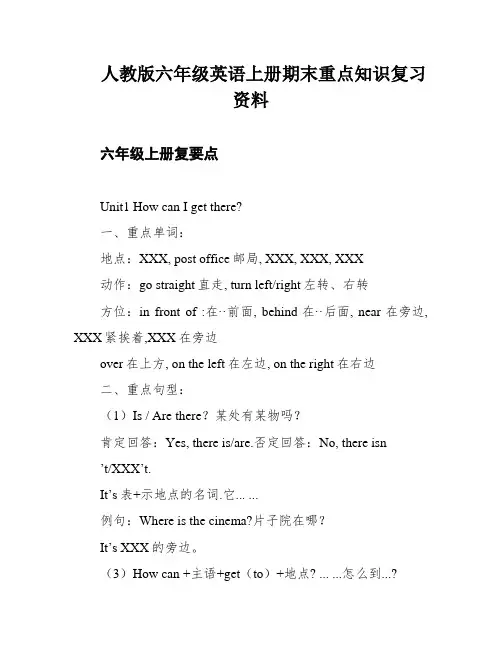
人教版六年级英语上册期末重点知识复习资料六年级上册复要点Unit1 How can I get there?一、重点单词:地点:XXX, post office邮局, XXX, XXX, XXX动作:go straight直走, turn left/right左转、右转方位:in front of :在··前面, behind在··后面, near在旁边, XXX紧挨着,XXX在旁边over在上方, on the left在左边, on the right在右边二、重点句型:(1)Is / Are there?某处有某物吗?肯定回答:Yes, there is/are.否定回答:No, there isn’t/XXX’t.It’s表+示地点的名词.它... ...例句:Where is the cinema?片子院在哪?It’s XXX的旁边。
(3)How can +主语+get(to)+地点? ... ...怎么到...?(假如get背面接的词为副词,则要省略介词to.)例句:How can we get there?我们怎样到那儿?同义句型:Can you tell me the way to +地点?-----Which is the wayto +地点?( 4 )Where is +地点?( 5 )Turn left/ right at+某地.Turn left at the bookstore.书店左转。
Unit 2 Ways to go to school?一、重点单词/短语:交通体式格局:XXX骑自行车/乘大众汽车/飞机/地铁/火车/船/出租汽车/轮渡take the No.57 bus乘57路公共汽车1on foot =walk步行其他:slow down慢下来, pay attention to注意, XXX交通信号灯,look right向右看,cross the road横穿马路, at home在家二、重点句型:(1)How do you come (to) +地点?你们怎么来...的?How do you go(to) +地址?你们怎样去...的?How do you get (to) +地址?你们怎样抵达...的?(频度副词:频度副词又称频率副词,用来表示事情发生的频率,即某事多长时间发生一次。
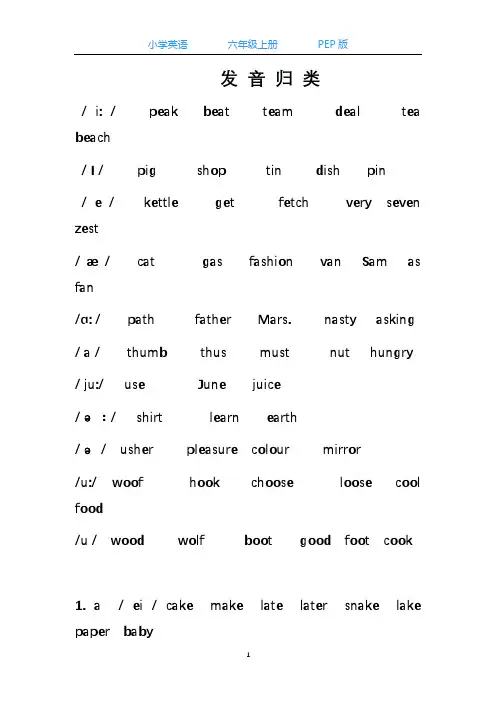
发音归类/ i: / peak beat team deal tea beach/ I / pig shop tin dish pin/ e / kettle get fetch very seven zest/ æ / cat gas fashion van Sam as fan/ɑ: / path father Mars. nasty asking / a / thumb thus must nut hungry / ju:/ use June juice/ ə:/ shirt learn earth/ ə / usher pleasure colour mirror/u:/ woof hook choose loose cool food/u / wood wolf boot good foot cook1. a / ei / cake make late later snake lake paper babya / æ /apple cat cap bag dad hat map black backa /ɑ:/ afternoon after banana dance lastclass glass grass grandma grandpa askfast fathera / ə/ china another woman breakfastaccountant bananaa / ɔ: / water a / ɒ/ watch wash want whata / i / orange2. e / i: / me he she these Chinese we returne / e / leg let bed pen desk yes egg3. i / ai / like kite bike drive time findlibrary excitedi / i / little fish big drink sit milk swimdig sister4. o / əu / Coke nose those close go homeno clotheso / ɒ/ lot dog holiday clock not boxodds hobby pot5. u / ju:/ use student cute excuse duty Tuesdayu / a / usher cut nut but bus cupjump much funnyu / ʊ / putu /u:/ June blue ruler superu / i / busy6. ea / i: / tea eat teacher please ice-creampeach jeans sneakers read meal beansclean season speak leaf leave(s) meaneast teach cleaner stream each sealseat beat wheatea / e / bread breakfast weatherea / ei / great7. ee /i:/ meet green three thirteen jeepqueen canteen sheep sweet beef weekend Halloween tree sleep need week feel seed deep between feet8. ow / au / brown how wow cow flowerdown now town crown shower ow / əu / yellow rainbow window snowy snow snowman know tomorrowrow show grow9. ou / au / mouth mouse out house ourplayground cloudy sour houseworkcloud about mountain southaccountant sprout loudou / u: / group soup coup10. th / ð / the this that these those fathermother brother with grandfathergrandmother clothes they themweather there either then othertogether anotherth / ө/ thank mouth birthday threethirteen thirty fourth eighth ninthtenth eleventh twelfth pathtwentieth thin Thursday healthynorth south month think themethinner thing something bathroom一、辨音,划线部分读音相同的打√,不同的打×(8%)()1. A. teacher B. bread()2. A. train B. wait()3. A. climb B. subway()4. A like B. pig()5. A foot B school()6. A bus B usually( ) 7.A stop B go( ) B plane二、找出划线部分发音不同与其他三个的单词。
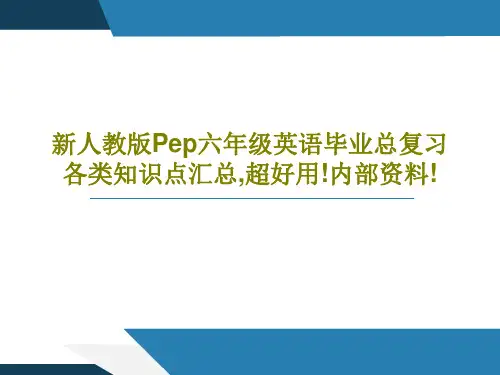
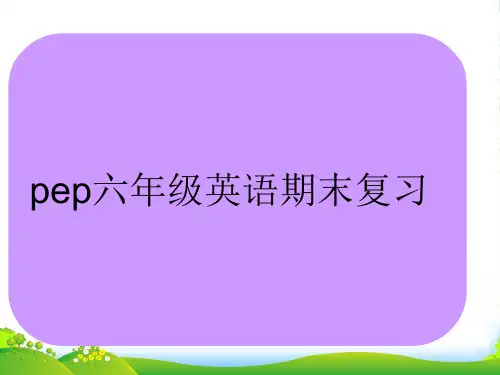
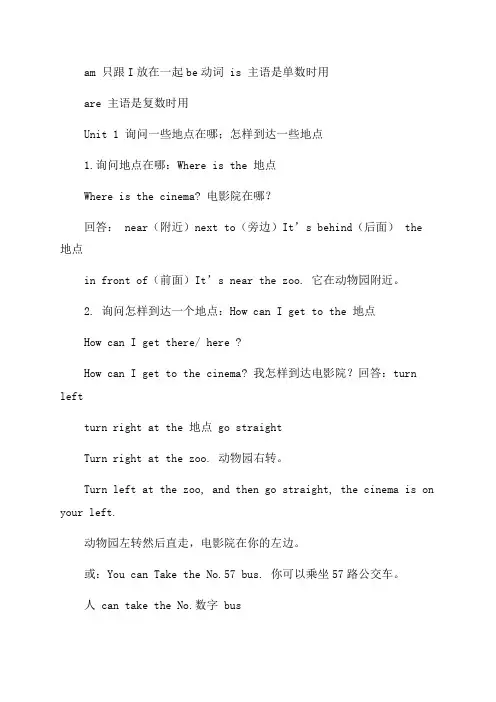
am 只跟I放在一起be动词 is 主语是单数时用are 主语是复数时用Unit 1 询问一些地点在哪;怎样到达一些地点1.询问地点在哪:Where is the 地点Where is the cinema? 电影院在哪?回答: near(附近)next to(旁边)It’s behind(后面) the 地点in front of(前面)It’s near the zoo. 它在动物园附近。
2. 询问怎样到达一个地点:How can I get to the 地点How can I get there/ here ?How can I get to the cinema? 我怎样到达电影院?回答:turn leftturn right at the 地点 go straightTurn right at the zoo. 动物园右转。
Turn left at the zoo, and then go straight, the cinema is on your left.动物园左转然后直走,电影院在你的左边。
或:You can Take the No.57 bus. 你可以乘坐57路公交车。
人 can take the No.数字 busUnit2 到达一些地点的交通方式doesHow do you go to school? 你怎么去学校?回答:人 go(goes) to school by 交通工具I go to school on foot. She goes to school by bus.2.人 must 动词原形人必须……People on bikes must wear one. 骑自行车的人必须戴一个。
I must pay attention to the traffic lights. 我必须注意交通信号灯。
Unit3 人打算做事1.人 be going to do(动词原形) 人打算(或将要)去做事She is going to see a film. 她打算去看电影。
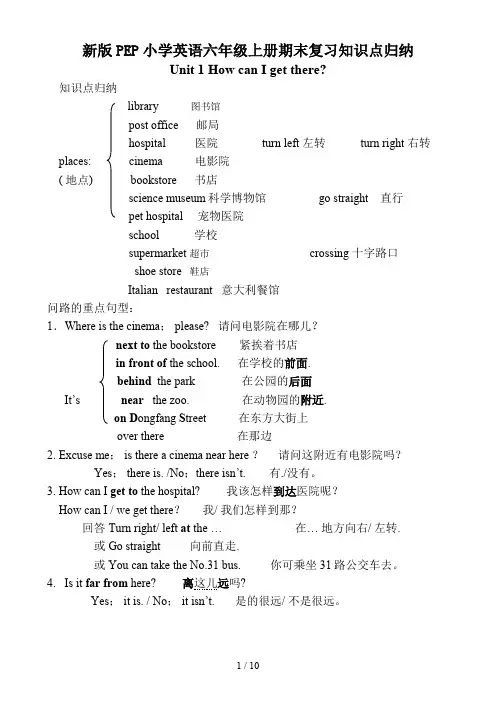
新版PEP小学英语六年级上册期末复习知识点归纳Unit 1 How can I get there?知识点归纳library 图书馆post office 邮局hospital 医院 turn left 左转 turn right 右转places: cinema 电影院( 地点) bookstore 书店science museum科学博物馆 go straight 直行pet hospital 宠物医院school 学校supermarket 超市 crossing 十字路口shoe store 鞋店Italian restaurant 意大利餐馆问路的重点句型:1.Where is the cinema; please? 请问电影院在哪儿?next to the bookstore 紧挨着书店in front of the school. 在学校的前面.behind the park 在公园的后面It’s near the zoo. 在动物园的附近.on D ongfang S treet 在东方大街上over there 在那边2. Excuse me; is there a cinema near here ?请问这附近有电影院吗?Yes; there is. /No;there isn’t. 有./没有。
3. How can I get to the hospital? 我该怎样到达医院呢?How can I / we get there?我/ 我们怎样到那?回答Turn right/ left at the … 在… 地方向右/ 左转.或Go straight 向前直走.或You can take the No.31 bus. 你可乘坐31路公交车去。
4. Is it far from here? 离这儿远吗?Yes; it is. / No;it isn’t.是的很远/ 不是很远。
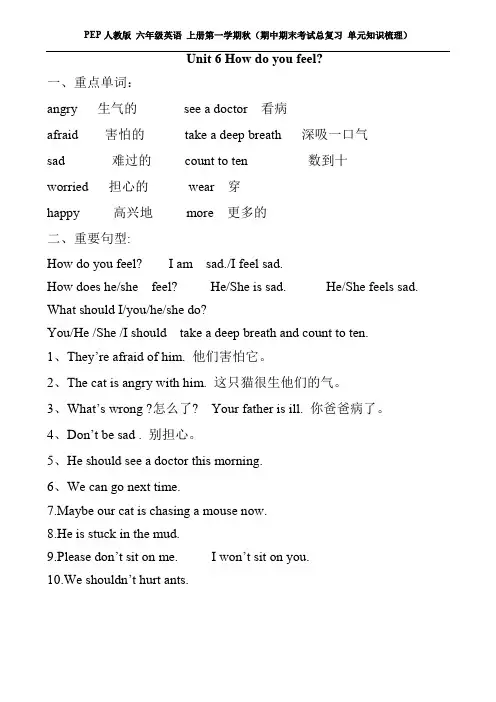
PEP人教版六年级英语上册第一学期秋(期中期末考试总复习单元知识梳理)
Unit 6 How do you feel?
一、重点单词:
angry 生气的see a doctor 看病
afraid 害怕的take a deep breath 深吸一口气
sad 难过的count to ten 数到十
worried 担心的wear 穿
happy 高兴地more 更多的
二、重要句型:
How do you feel? I am sad./I feel sad.
How does he/she feel? He/She is sad. He/She feels sad. What should I/you/he/she do?
You/He /She /I should take a deep breath and count to ten.
1、They’re afraid of him. 他们害怕它。
2、The cat is angry with him. 这只猫很生他们的气。
3、What’s wrong ?怎么了? Your father is ill. 你爸爸病了。
4、Don’t be sad . 别担心。
5、He should see a doctor this morning.
6、We can go next time.
7.Maybe our cat is chasing a mouse now.
8.He is stuck in the mud.
9.Please don’t sit on me. I won’t sit on you.
10.We shouldn’t hurt ants.。
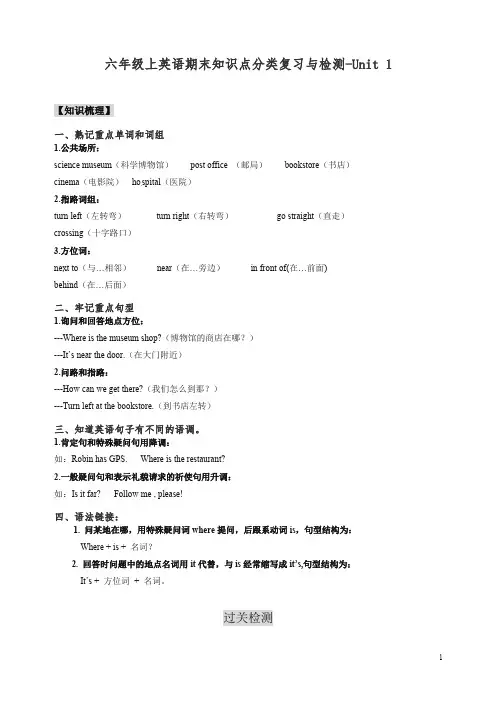
六年级上英语期末知识点分类复习与检测-Unit 1【知识梳理】一、熟记重点单词和词组1.公共场所:science museum(科学博物馆)post office (邮局)bookstore(书店)cinema(电影院)hospital(医院)2.指路词组:turn left(左转弯)turn right(右转弯)go straight(直走)crossing(十字路口)3.方位词:next to(与…相邻)near(在…旁边)in front of(在…前面)behind(在…后面)二、牢记重点句型1.询问和回答地点方位:---Where is the museum shop?(博物馆的商店在哪?)---It’s near the door.(在大门附近)2.问路和指路:---How can we get there?(我们怎么到那?)---Turn left at the bookstore.(到书店左转)三、知道英语句子有不同的语调。
1.肯定句和特殊疑问句用降调:如:Robin has GPS. Where is the restaurant?2.一般疑问句和表示礼貌请求的祈使句用升调:如:Is it far? Follow me , please!四、语法链接:1. 问某地在哪,用特殊疑问词where提问,后跟系动词is,句型结构为:Where + is + 名词?2. 回答时问题中的地点名词用it代替,与is经常缩写成it’s,句型结构为:It’s + 方位词+ 名词。
过关检测Listening Part(共30分)一、听录音,圈出你所听到的单词。
(5分)1.postman postcard post office2.music museum cinema3.bookstore shoe store story book4.turn left next to turn right5.straight crossing hospital二、听录音,判断下列图片与你听到的内容是否相符,相符的打“T”,不相符的打“F”。
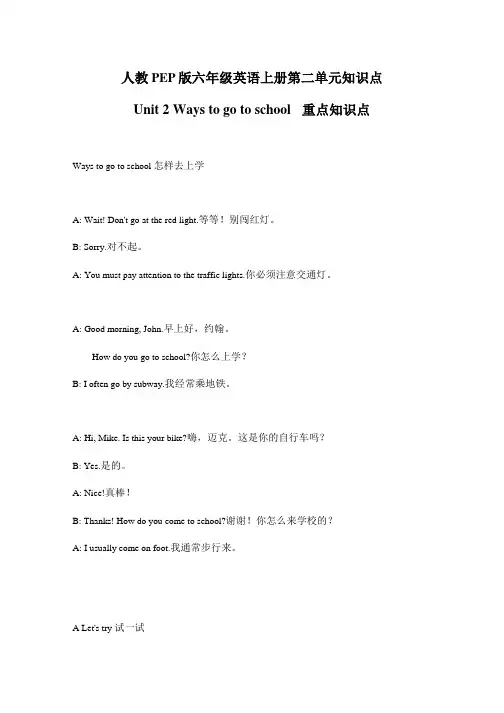
人教PEP版六年级英语上册第二单元知识点Unit 2 Ways to go to school 重点知识点Ways to go to school 怎样去上学A: Wait! Don't go at the red light.等等!别闯红灯。
B: Sorry.对不起。
A: You must pay attention to the traffic lights.你必须注意交通灯。
A: Good morning, John.早上好,约翰。
How do you go to school?你怎么上学?B: I often go by subway.我经常乘地铁。
A: Hi, Mike. Is this your bike?嗨,迈克。
这是你的自行车吗?B: Yes.是的。
A: Nice!真棒!B: Thanks! How do you come to school?谢谢!你怎么来学校的?A: I usually come on foot.我通常步行来。
A Let's try 试一试Amy meets Mike at school this morning.艾米早上在学校遇到了迈克。
Listen and tick or cross.听,然后打勾或打叉。
A: Morning, Mike.早上好,迈克。
B: Morning.早上好。
Hey, don't forget.嘿,別忘了。
Mrs Smith will take us to the nature park next Wednesday. 下周三史密斯夫人要带我们去自然公园。
A: Oh, yes.哦,是的。
How do we get to the nature park?我们怎么去自然公园?B: By bus.坐公交车去。
A: Look! There's Mrs Smith now.看!史密斯夫人来了。
Let's talk 谈话Mike: Good morning, Mrs Smith!早上好,史密斯夫人!Mrs Smith: Hi, children.嗨,孩子们。
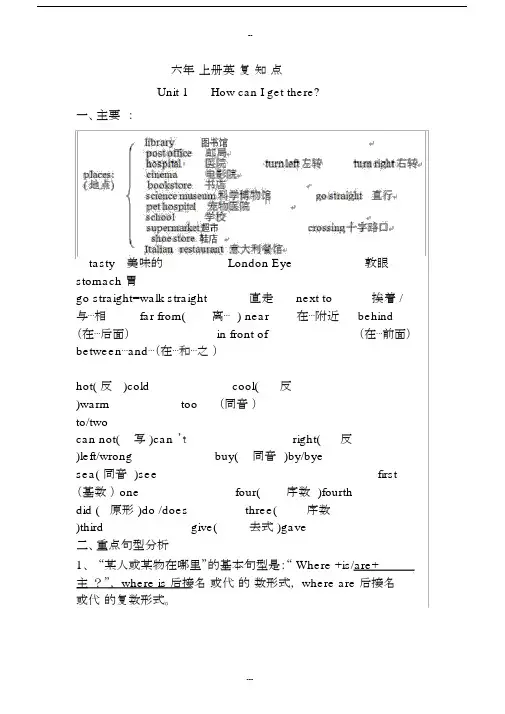
--六年上册英复知点Unit 1How can I get there?一、主要:tasty 美味的London Eye敦眼stomach 胃go straight=walk straight直走next to挨着/与⋯相far from(离⋯) near在⋯附近behind (在⋯后面)in front of(在⋯前面)between⋯and⋯(在⋯和⋯之)hot( 反 )cold cool(反)warm too(同音)to/twocan not(写)can’t right(反)left/wrong buy(同音)by/byesea( 同音 )see first (基数) one four(序数)fourthdid (原形)do /does three(序数)third give(去式)gave二、重点句型分析1、“某人或某物在哪里”的基本句型是:“ Where +is/are+ 主?”, where is 后接名或代的数形式, where are 后接名或代的复数形式。
--表示地点的:museum博物 , post office局, bookstore 店 , cinema 影院 , hospital 医院 restaurant 餐 bank 行 bus stop 公交站 lake 湖 library zoo 物园 school 学校 park 公园 garden 花园 hotel 旅2.It ’s near the door.此句中 near 是表示位置的介,意“旁,附近”,其同句是: It ’s next to the door.它在的旁。
表示位置的短:next to the bookstore挨着店near the hospital在医院附近near the post office在局附近 over there在那on Dongfang Street在方大街上 in front of the school在学校前面3.How can we get there?此句用来“怎去某地”,后面直接跟地点。
人教版(PEP)小学英语六年级上册教材知识点
Unit 1 How can I get there ? 一、主要单词: museum博物馆 bookstore书店 cinema电影院 turn 转弯 hospital医院 left向左 post office 邮局 science科学 right向右 straight笔直地 crossing十字路口 二、习惯语搭配: post office邮局 science museum科学博物馆 pet hospital宠物医院 Italian restaurant意大利餐馆 Beihai Park北海公园 Palace Museum故宫博物院 go straight直走 turn right/left右/左转 next to挨着 in front of...在...前面 near the park在公园附近 on Dongfang Street在东方大街上 三、惯用表达式: Excuse me 打扰一下 Follow me, please!请跟着我! 四、公式化句型: 1、问路的句型及其答语: 问句:Where is the + 地点? ···在哪儿? 答语:It’s + 表示地点的词语。 它···。 next to the bookstore, near the hospital/post office, over there, on Dongfang Street, in front of the school... 2、询问怎么到某地的句型及其答语: 问句:How can +主语 + get (to)+地点? ···怎么到···? 同义句型: Can you tell me the way to +地点? Where is + 地点? Which is the way to +地点? 答语:Turn +方向+表示地点的介词短语。 ···转。 at the cinema at the corner near the post office... 五、例句: Where is the cinema, please? 请问电影院在哪里? It’s next to the hospital. 它与医院相邻。 Turn left at the cinema, then go straight. It’s on the left. 在电影院向左转,然后直行。它在左边。 Turn left at the bank。 在银行左转。 Unit 2 Ways to go to school 一、主要单词: by乘 bus公共汽车 on foot步行 plane飞机 taxi出租车 ship(大)船 subway地铁 train火车 slow慢的 stop停下 always 总是,一直 usually 通常 often经常 sometimes 有时候 never 从来不 二、习惯语搭配: by bike/bus/plane/subway/train/ship/taxi/ferry 骑自行车/乘公共汽车/飞机/地铁/火车/船/出租汽车/渡轮 take the No.57 bus乘57路公共汽车 on foot步行 slow down慢下来 pay attention to注意 traffic lights 交通信号灯 look right向右看 cross the road横穿马路 get off下车 at home在家 traffic rules交通规则 get to到达 get on 上车 be far from…表示离某地远 三、惯用表达式: Wait!等一等! Hooray太好了! I see. 我明白了。Go at a green light 绿灯行 Stop at a red light 红灯停 Wait at a yellow light 黄灯等 四、公式化句型: 1、如何询问对方的出行方式: How do you come(to)+地点? 你(们)怎么来···的? 2、如何用must表示必须做某事: 某人+must+动词原形(+其它). ···必须···。 3、告诫别人不要做某事的句型: Don’t +动词原形(+其它). .不要/别···。 五、例句: How do you go to school? 你怎么去上学? Usually I go to school on foot. Sometimes I go by bus. 通常我步行去上学。有时候骑自行车去。 How can I get to Zhongshan Park ? 我怎么到达中山公园? You can go by the No. 15 bus. 你可以坐15路公共汽车去。 I am far from school now. 我现在离学校很远。 My home is not far from our school. My home is near our school. 我家离学校不远。 Unit 3 My weekend plan 一、主要单词: tomorrow明天 film电影 supermarket超市trip旅行 tonight在今晚 evening晚上/傍晚 next week下周 comic连环画杂志 dictionary词典 word单词 post card明信片 visit拜访 二、习惯搭配: take a trip去旅行 go for a picnic去野餐 go to the cinema去看电影 learn to swim学习游泳 visit my grandparents看望我(外)祖父母 get together 聚会 go to the supermarket去超市 go ice-skating去滑冰 make a snowman堆雪人 see a film看电影 make mooncakes做月饼 read a poem朗诵一首诗 this weekend这周末 Renmin Park人民公园 next week下周 this morning/afternoon/evening今天上午/下午/晚上 next Wednesday下星期三 三、惯用表达式: What about you?你呢? Here they are!它们在这儿! Can I help you?我能帮助你吗? Sounds great!听起来很棒! Have a good time!玩得开心! You too.你也是 四、公式化句型: 1、询问对方打算做什么的句型及其答语: 问句:What are you going to do +其它? 你/你们···打算做什么? next week tonight tomorrow this morning/afternoon/evening this weekend... 答语: I’m/We’re going to +动词(短语)原形+其它. 我/我们打算···。 see a film take a trip visit my grandparents watch TV... 2、询问对方打算去哪儿的句型及答语: 问句:Where are you going(+将来时间)? 你/你们打算(···)去哪儿? 答语:I’m/We’re going (to the)+地点. 我/我们打算去···。 3、询问对方打算何时去做某事的句型及答语: 问句:When are you going to +动词(短语)原形? 你/你们打算什么时候···? 答语:I’m/We’re going to +动词(短语)原形+将来时间. 我/我们打算···。 五、例句: What are you going to do on the weekend? 你周末打算做什么? I’m going to visit my grandparents this weekend? 这个周末我打算去看望我的外祖父母。 Where are you going this afternoon? 你今天下午打算去哪里? I’m going to the bookstore. 我打算去书店。 What are you going to buy? 你打算去买什么? I’m going to buy a comic book。 我打算去买一本漫画书。 Unit 4 I have a pen pal 一、主要单词: studies学习(第三人称单数形式) puzzle谜 hiking远足 二、习惯搭配: read stories读故事 do kungfu练功夫 fly kites放风筝 play the pipa弹琵琶 play sports进行体育活动 climb mountains爬山 listen to music听音乐 sing English songs唱英文歌 on a farm在一个农场里 live in...住在··· write an email to...给···写一封电子邮件 on the playground在运动场上 三、惯用表达式: Me too.我也是。 Really?真的吗? 四、公式化句型: 1、询问某人爱好的句型及其答语: 问句:What are sb.’s hobbies? ···有什么爱好? 答语:主语+like/likes+动词-ing形式(+其它). ···喜欢···。 singing dancing reading stories playing football doing kungfu doing word puzzles going hiking watching TV drawing cartoons listening to music going fishing 2、由do/does引导的一般疑问句及其答语: 问句:Do/Does+主语+动词原形+其它? 答语:Yes,主语+do/does. /No,主语+don’t/doesn’t. 五、语法: 1、动词变为动名词的规则: 动词变为动名词,即是动词加ing。一般要遵循以下三条规则: (1)一般情况下,在动词的后面直接加ing。如: play—playing read—reading do—doing go—going (2)以不发音的字母e结尾的动词,要去掉不发音的字母e,再加ing。如: write—writing ride—riding make—making dance—dancing (3)以单元音加单辅音结尾的重读闭音节,要双写最后一个辅音字母,再加ing。如: run—running swim—swimming put—putting sit—sitting